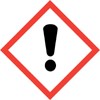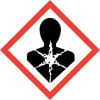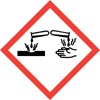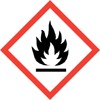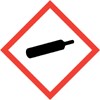As an employer, you’re responsible for protecting your employees against health hazards in the workplace. In this article, we look at your obligations under the Control of Substances Hazardous to Health (COSHH) regulations, including performing risk assessments and delivering training to your employees. We also direct you to further resources.
The United Kingdom has various laws and regulations concerning workplace health and safety. As an employer, you must comply with obligations to keep your employees safe and reduce the risk of penalties for noncompliance.
However, workplace health and safety rules are complex, and trying to understand all your obligations can feel daunting. There are various laws and regulations, from general workplace requirements to specific rules for hazardous substances.
In this article, we guide you through the Control of Substances Hazardous to Health (COSHH) regulations. This collection of rules protects employees by controlling exposure to hazardous substances. We take you through your main responsibilities as an employer, showing you how to conduct a COSHH risk assessment and where to go for further information.
Key Takeaways
- COSHH refers to the Control of Substances Hazardous to Health Regulations 2002. These regulations apply to all employers in the UK and some self-employed workers.
- COSHH regulations set out what employers and employees must do to remove or reduce the risk of employee exposure to substances that are hazardous to their health. Hazardous substances include dust, gases, fumes, chemicals, biological agents, germs, and nanotechnology.
- Employer responsibilities include preventing or reducing exposure to hazardous substances, regularly performing risk assessments, and providing adequate training to employees and contractors.
- Failing to comply with your obligations under COSHH may result in financial penalties or even imprisonment.
What Does COSHH Stand For?
COSHH stands for the Control of Substances Hazardous to Health (COSHH) Regulations 2002.
All UK employers must follow these standards to prevent exposing employees or worksite visitors—or limit their risk of exposure—to hazardous substances. COSHH is part of the UK’s workplace safety and health framework that aims to reduce the risk of workplace injuries, illnesses, and deaths.
Under COSHH, employers must identify hazardous substances in the workplace, understand how they can harm people’s health, and implement steps to reduce the risk of harm. These steps include performing risk assessments, providing training, and conducting health surveillance where necessary.
If you have employees, all COSHH requirements apply to you. If you don’t have employees but transport hazardous substances to other workplaces—for example, as a self-employed contractor—COSHH applies to you, except for the monitoring and health surveillance regulations.
COSHH applies to all industries in the UK, too. When discussing hazardous substances, many people think of dangerous sectors like manufacturing or mining. However, every workplace has hazardous substances—including restaurants, offices, and hairdressing salons.
The Health and Safety Executive (HSE), the national workplace health and safety regulator in the UK, enforces COSHH.
What is a hazardous substance?
A hazardous substance is any material that could cause harm to a person who inhales, ingests, or otherwise comes into contact with it. Contact may be via the skin, cuts, and needlestick injuries.
The harm may be immediate, through burns or skin irritation (dermatitis), or long-term, like cancer or lung disease. The effects of hazardous substances can also vary in severity. They include headaches, nausea and vomiting, irritation or injuries to the eyes, allergic reactions, infections, nervous system disorders, and—in severe cases—death.
Hazardous substances include those used in and created by workplace processes. Hazardous substances under COSHH may be dust, gases, fumes, powders, gels, fibres, liquids, biological agents, micro-organisms like bacteria or viruses, or nanotechnology like carbon nanotubes used in manufacturing.
Examples of hazardous substances include:
- Paints
- Chemicals
- Welding dust
- Wood dust
- Flowers and plants
- Lubricants
- Detergents, bleach, and other cleaning products
- Beauty products
COSHH doesn’t apply to all hazardous substances, as some substances—including especially harmful ones—warrant their own regulations. For instance, separate regulations cover lead, asbestos, and radioactive materials.
Why is COSHH important for employers?
Following COSHH regulations helps provide employees and visitors with a safe work environment. These regulations provide a framework for assessing your workplace and identifying, removing, and reducing the risk of harm.
Workplace injuries and illnesses continue to occur despite stricter standards and improved compliance. According to the HSE, 565,000 workers were involved in non-fatal workplace injuries in 2021-2022. Additionally, each year, 12,000 lung disease deaths are linked to previous workplace exposure.
COSHH aims to reduce the risk of workplace illnesses and injuries caused by hazardous substances. This not only protects employees but also benefits employers.
For example, employers save money when they provide employees with safe working conditions. The HSE estimates that workplace injuries and illnesses (not including long-term conditions) cost employers £3.5 billion in 2019-2020. Ensuring safe working conditions also helps reduce absenteeism related to workplace illnesses and injuries.
Providing employees with a safe work environment improves their productivity, too. When workers feel safe at work, they’re more likely to complete their work efficiently and without incident.
Plus, establishing your reputation as a safe workplace helps you attract the best candidates, especially in higher-risk industries like manufacturing. A strong reputation increases trust among your customers as well, potentially leading to more business.
Conversely, you risk facing harsh penalties if you don’t comply with COSHH. These penalties include unlimited fines and imprisonment. The court can also order you to take other remedial action. You may need to publish a statement about the incident and the penalty imposed or provide compensation to an injured person.
💡Pro Tip:
Connecteam is the ideal tool to help your organisation stay compliant. You can use it to centrally store policies, employee certifications, and training records. Plus, it lets you notify your employees of any regulation changes in real time.
COSHH Responsibilities for Employers and Employees
Employer responsibilities
Under COSHH, employers are required to do the following:
- Prevent or reduce workers’ exposure to hazardous substances.
- Take reasonable steps to remove or reduce the risk of exposure to hazardous substances via control measures and ensure employees follow these measures.
- Regularly perform COSHH risk assessments.
- Maintain control measures in good condition through examination and testing.
- Keep a record of these examinations and tests and subsequent repairs.
- Provide employees with adequate training and information on hazardous materials in the workplace. This includes sharing the findings of COSHH risk assessments.
- Regularly check and replace personal protective equipment (PPE) as necessary.
- Have accident and emergency procedures to respond to incidents involving hazardous substances.
- Monitor employees exposed to hazardous substances.
- Comply with workplace exposure limits (WELs) for certain hazardous substances.
- Supervise employees to ensure they perform their work duties as required.
Employee responsibilities
COSHH regulations require employees to do the following:
- Help colleagues create a safe workplace.
- Follow the COSHH procedures and control measures used in their workplace.
- Use PPE properly.
- Report any defects with equipment provided as a COSHH control measure.
- Report hazards or incidents relating to hazardous substances.
- Attend necessary medical check-ups.
- Follow official cleaning and showering procedures.
- Complete any required workplace training.
How to Conduct a COSHH Assessment
A COSHH assessment helps you identify potentially hazardous substances in your workplace, their risks to employee health and safety, and ways to remove or reduce these risks.
Like risk assessments under the Management of Health and Safety at Work Regulations, COSHH assessments aim to reduce the risk of work-related injuries or illnesses. However, while risk assessments consider all potential workplace hazards, a COSHH assessment relates to hazardous substances only and should be done separately.
These are the steps involved in a COSHH risk assessment:
Review your processes to identify hazards
Examine each system and process used in your workplace to identify any potentially hazardous substances used or created by them. Closely reading the labels on any products your business uses—and their safety data sheets, if available—can help.
You should also ask your suppliers for information about potentially hazardous substances you buy from them.
Evaluate the risks
Once you know the hazardous substances in your workplace, identify who’s at risk of exposure. This may be individuals in specific roles or groups of employees. You must also consider any visitors to your workplace, like contractors or customers.
When you know who’s at risk of exposure, consider the degree of risk the substances pose to them. Factors to consider include:
- How hazardous the substance is. For example, you might consider a detergent that causes minor skin irritation when overused to be less hazardous than sodium hydroxide (also known as lye or caustic soda), which can cause immediate and severe burns.
- How frequently or long are people exposed to the substance. Working with harmful substances daily typically puts an employee at greater risk than occasional use.
- How much of the substance is typically used. Some hazardous substances may represent a small risk when used in small quantities.
- How people are exposed to the substance. This may be through inhaling, swallowing, or coming into contact with the skin or eyes, including through skin punctures.
- Which activities potentially expose individuals to a harmful substance to a high degree. These may include certain manufacturing processes or activities involving frequent exposure to hazardous substances, like certain waste management activities.
- Which exposure limits or equivalents apply. These include WELs and biological monitoring guidance values (BMGVs). Exposure limits define maximum allowable concentrations of certain hazardous substances in the air. To protect employees’ health, employers must ensure these substances do not exceed these limits.
- What your previous findings reveal. This includes what you’ve uncovered in earlier COSHH assessments, health surveillance, or exposure monitoring in the workplace.
Identify ways to remove or address risks
By understanding who’s at risk and the degree of risk posed to them, you can identify appropriate control measures. Control measures are steps you can take to remove or reduce the risk of the hazardous substance harming someone.
The control measures you choose to implement depend on the substance, the nature of the risk, the specific process the substance is involved in, and your industry. Under COSHH, employers must use a combination of control measures to address risks.
The COSHH regulations outline an order of priority when implementing control measures to prevent exposure to hazardous substances. Firstly, you should replace the substance with a safer alternative.
If this isn’t possible, you should then (in order of priority):
- Introduce work processes, systems, equipment, and materials that remove or reduce the risk of exposure to hazardous substances.
- Control exposure at the source—for example, through ventilation.
- Provide PPE to employees.
Examples of control measures to consider include:
- Using safer products to replace hazardous substances.
- Using different processing methods—for example, heating the product to a different temperature to reduce vapours.
- Implementing better cleaning procedures.
- Placing cleaning tools near a worksite for easy access in case of a spill or accident.
- Restricting access to certain substances or locations to approved employees only.
- Improving ventilation with a local exhaust ventilation system (LEV) to extract vapours, dust, gases, etc. LEVs must be tested at least every 14 months.
- Moving an activity to a better-ventilated location.
- Using appropriate storage procedures and containers, including properly labelling hazardous products.
- Changing work schedules—for example, limiting the number of consecutive shifts employees can do in a particular department to limit their exposure to a hazardous substance.
- Restricting who has access to specific work sites or locations in a workplace.
- Establishing a written waste disposal plan with accompanying workplace signs.
- Requiring the use of provided PPE.
- Providing employees and onsite visitors with adequate training. This includes educating them about the risks and control measures in place and what they must do to follow them.
Specific COSHH control measures apply to carcinogens—cancer-causing substances—and biological agents where the employer can’t prevent exposure. These include banning eating and drinking in locations potentially contaminated by carcinogens and making vaccines available to employees to protect them from biological agents. These measures aim to reduce the risk to workers where the employer can’t remove the risk altogether.
When considering control measures, identify who’s responsible for implementing them and overseeing their continued use. Determining when to introduce control measures is also important.
Record your assessment in writing
Employers with 5 or more employees are required by law to record their COSHH risk assessment.
But, regardless of how many employees you have, creating a written record of your assessment is a good idea. It documents your steps and demonstrates your commitment to COSHH compliance. It also provides a reference document for your employees to follow.
The record should summarise the findings of your COSHH assessment and set out the steps you’ll take to address any risks. It should note the following:
- Details of the hazard.
- Details of the potential harm.
- Existing control measures to address the hazard.
- Further control measures you will introduce.
- Those responsible for implementing the control measure and ensuring employees’ compliance.
- The date by which you will introduce the control measure.
- Any specific employee training needs the assessment identifies.
- Emergency plans.
- Details of any ongoing monitoring or health surveillance required.
- The date you’ll review your COSHH assessment.
Writing a COSHH policy is also a good idea if you don’t already have one. This document outlines your commitment to providing a safe work environment and complying with COSHH regulations. You can also set out the measures you use to reduce the risk of exposure to hazardous substances and employee responsibilities.
🧠 Did You Know?
Connecteam’s library of free templates makes it easy to create key internal documents, including policies.
Your policy should explain how employees can raise any COSHH-related concerns and identify the person responsible for COSHH compliance in your organisation.
Store your policy in a central location where your employees can easily access it—for example, your employee handbook. Including your policy in your onboarding materials for new employees is also a good idea.
💡 Pro Tip:
Use Connecteam’s knowledge base feature to securely and centrally store important internal documents like your employee handbook, policies, and training materials.
Regularly review and update your assessment
You must regularly review and update your COSHH assessment to identify and change any ineffective control measures. Revisit it whenever it becomes irrelevant, there’s been a major change to the work, or you’re required to for exposure monitoring.
Your workplace, workforce, processes, and procedures change regularly, as can the COSHH requirements. It’s crucial to stay on top of any developments to comply with your COSHH obligations and keep your workers safe.
💡 Pro Tip:
Designate someone in your organisation to oversee consistent COSHH compliance. They don’t need any specific qualifications to do this. However, they must have the knowledge, skills, and experience to assess hazards and risks and choose suitable control measures.
After a COSHH Assessment: Monitoring, Surveillance, and Training
Monitoring
If your COSHH assessment finds that it’s necessary to control employees’ exposure to hazardous substances or otherwise protect their health, you must monitor employees’ exposure to ensure proper management.
This will help you comply with exposure limits designed to protect workers’ health, such as the WELs and BMGVs. It will also help you identify when you need to replace control measures, like PPE.
You must monitor activities regularly or after any change that could affect exposure. The COSHH regulations also specify the monitoring frequency for two substances and processes—vinyl chloride monomer and spray resulting from an electrolytic chromium process.
Also, you must keep monitoring records for 40 years if they concern personal exposures of identifiable employees. Otherwise, you must store them for 5 years from the date of their last entry.
Health surveillance
You may also need to put certain employees who’ve been exposed or are likely to be exposed to a hazardous substance under health surveillance. This involves collecting information about an employee’s health to reduce their risk of harm.
You’re required to use surveillance if the substance is associated with a disease, the disease can be detected and treated to reduce further harm, and workplace conditions mean the disease will likely develop.
For example, if a work process produces organic dust linked to lung disease, you may need to organise regular medical check-ups to assess employees’ lung function.
COSHH also lists certain substances for which health surveillance is appropriate, depending on their use. These include vinyl chloride monomer, carbon disulphide, and pitch.
You must keep health surveillance records for 40 years after their last entry.
Training
Employers must provide appropriate COSHH training to their employees. This training should cover the following:
- The hazards and risks your COSHH assessment identified.
- Control measures used in the workplace.
- Relevant workplace exposure limits.
- General outcomes of exposure monitoring or health surveillance.
- Accident and emergency procedures.
You can build your own training program or engage an external consultant to help you design a suitable training program. It’s also worth keeping a record of your employees’ training to ensure it remains up to date.
🧠 Did You Know?
With Connecteam, you can create and deliver training courses directly to your employees’ devices. You can also securely store all training materials and records and track your workers’ progress in real time.
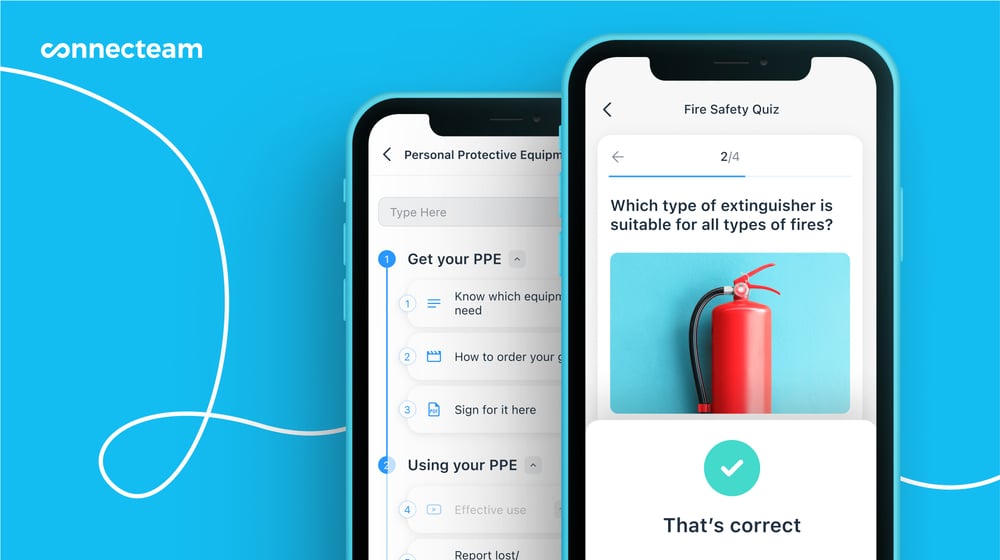
There are also various types of general COSHH training courses available. For example, the British Safety Council offers online COSHH training for employers and employees. Also, check with your local colleges or trade associations for training programs they offer.
What Are COSHH Symbols?
You can use COSHH symbols to warn people of potential hazards in the workplace and reduce the risk of harm. Below are some common ones.
COSHH and Related Regulations
The COSHH regulations are part of the UK’s workplace health and safety compliance framework. As an employer, you may need to comply with overlapping laws and regulations relating to occupational health and safety.
Some other workplace health and safety laws and regulations that may apply to you include:
- Health and Safety at Work etc. Act 1974: The central workplace health and safety law in the UK, setting out the obligations of employers, employees, and the self-employed.
- UK Registration, Evaluation, Authorisation, and Restriction of Chemicals (REACH): A law that generally applies to manufacturers or importers dealing with large quantities of hazardous chemicals—i.e., 10 or more tonnes.
- Reporting Injuries, Diseases, Dangerous Occurrences Regulations (RIDDOR): Regulations requiring employers to report workplace accidents, diseases, or dangers.
- Classification, Labelling and Packaging (GB CLP) of Substances and Mixtures Regulation: Regulations that apply to businesses that import, manufacture, mix, or distribute chemicals for supply purposes.
- Carriage of Dangerous Goods and Use of Transportable Pressure Equipment Regulations: Regulations apply to businesses transporting chemicals by road or rail.
Where to Find Further Information About COSHH
The COSHH regulations are complex, and it’s essential that you properly understand your obligations as an employer under them. Otherwise, you may face severe penalties for noncompliance and put your workers at increased risk of harm.
The HSE has various resources on COSHH, including a brief general guide and industry-specific guides. If you’re a trade association member, these resources can assist you with aspects of COSHH compliance, like training and testing LEVs.
There are also registers of consultants who advise businesses on occupational safety and health compliance generally, as well as workplace health risks specifically.
📚 This Might Interest You:
Check out our article for 10 practical tips for creating a culture of compliance at your business.
The Bottom Line on COSHH
The health and safety of your employees and people on your worksite is paramount. When it comes to dangerous substances that are hazardous to health, COSHH sets out several regulations. As an employer, you must comply with these to reduce the risk of any penalties for noncompliance and—most importantly—protect employees’ well-being.
By understanding COSHH’s meaning and objectives, you can work towards complying with your legal obligations as an employer and providing employees with the safest work environment possible.
FAQs
Who’s responsible for COSHH in your workplace?
Employers are responsible for removing or reducing the risk of employees’ exposure to hazardous substances in the workplace. Employers may appoint a person or team to oversee workplace health and safety, including the risk assessments and training involved in COSHH compliance. Employees must follow any COSHH measures in their workplace.
What does COSHH cover in the workplace?
COSHH covers hazardous substances in the workplace. It sets out how employers can remove or reduce the risk of these substances causing harm to employees and others. Hazardous substances include chemicals, dust, fumes, gases, fibres, and nanotechnology.
Disclaimer
The information on this website about COSHH regulations in the UK is a summary for informational purposes only. Laws and regulations regularly change and may vary depending on individual circumstances. While we have made every effort to ensure the information provided is up to date and reliable, we cannot guarantee its completeness, accuracy, or applicability to your specific situation. Therefore, we strongly recommend that readers seek guidance from their legal department or a qualified lawyer to ensure compliance with applicable laws and regulations. Please note that we cannot be held liable for any actions taken or not taken based on the information presented on this website.



